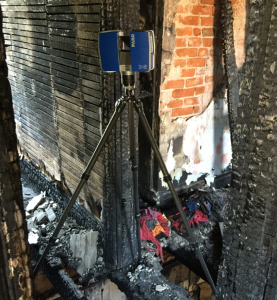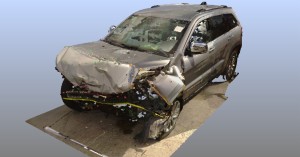3D laser scanning: Essential technology in forensic science and claims
When it comes to the claims industry, documentation is essential. In order to come to a conclusion regarding the cause of a fire, traffic accident or product failure, it is crucial for forensic investigators to document in a clear and effective manner. Today, technology plays an important role in improving the quality, speed and quantity of evidence collection; an investigation can be concluded with a higher amount of certainty in a shorter amount of time. The use of 3D scanning technology allows investigators to preserve a permanent, digital copy of a scene that can be viewed virtually via computer. Investigators can conveniently observe evidence, navigate throughout different environments, and take measurements as if still onsite.
What is 3D laser scanning?
There are several 3D scanning technologies available on the market today, and among the most useful for the forensics industry are 3D laser scanners. 3D laser scanning is the process of capturing millions of points of data and converting them into a virtual environment, or point cloud. These point clouds are used to produce highly accurate and realistic 3D computer models for use in many applications.
Unified employs a laser scanner that works by emitting an infrared laser at a surface which is then reflected back to the scanner. The distance from the object to the scanner is calculated by analyzing the phase shifts in the wavelength between the emitted and returning light. This technology is capable of collecting data at a rate of nearly 1 million points per second at accuracies under 2mm at a distance of 1,000ft. In addition to measuring distance, the scanner takes high-resolution photographs which are used to assign a color value to each individual point allowing for the creation of realistic, full-color point clouds.
Why 3D laser scanning?

At typical loss sites, investigators must often choose which parts of the scene are relevant to the investigation and then proceed with documentation accordingly. Often, evidence may not be deemed relevant until late in the analysis, at which point the scene or vehicle may have been changed, making measurements impossible to collect. By creating a digital copy of the scene, sensitive evidence can be preserved that may otherwise be compromised over time. Additionally, there are always “missing photographs” from an inspection that may add value to an investigation. This is no longer an excuse. By taking a comprehensive scan of the scene, typically all potential information of interest is captured and available for future use.
Traditional investigations are generally completed using a combination of tape measures, measuring wheels and photographs. Having so many tools can make documenting large, complex scenes in a timely manner very difficult. In contrast, 3D laser scanning provides more complete and accurate information in a fraction of the time. Each and every collected data point can be referenced and measured much more efficiently using specialized software. The scanner can also easily collect dimensional information that is difficult to gather due to sheer size, accessibility or safety concerns.
3D scanning technology has been around for several decades and has widespread acceptance across a variety of industries. A few examples include forensic and criminal investigations, product design and manufacturing, land surveying, medical science, film and video game production, and the documentation of historical artifacts. Companies use laser scanning to increase efficiency, provide faster turnarounds on projects, reduce labor costs, and add value to customer deliverables. Accuracy and speed lead to predictability, which in turn brings about increased profitability.
How Unified uses 3D laser scanning
- Creation of 3D walk-throughs allowing juries/audiences to be immersed in an environment; witness points of view can be replicated and incidents can be reenacted in real time
- Complete documentation of complex dimensional information for vehicle crush, building damage and burn patterns
- Creation of 2D and 3D building layouts, industrial projects and traffic scenes
- Scans of evidence, such as vehicles or other objects of interest, which can be placed in separately scanned environments to explore hypothetical scenarios
- Scans used to increase the accuracy of calculations in engineering simulations for accident reconstruction, structural analysis and fires
Investigations have been changed forever thanks to advanced technologies like 3D laser scanning. Efficiencies and advantages can be realized when information needed by investigators is readily available for future use, no matter what happens to the evidence or the scene. If you would like to learn more about different technologies that Unified Investigations & Sciences is using to enhance our investigations, visit our website at www.uis-usa.com or read more in our previous blog posts.
Please feel free to reach out to us with questions and ideas in the comments section – we love to hear from you.
Seth Behrens, P.E., Forensic Engineer and Nic Cheek, Forensic Consultant
Unified Investigations & Sciences, Inc., a Sedgwick company